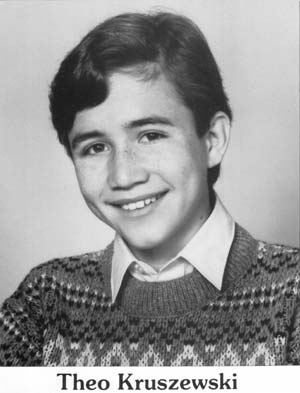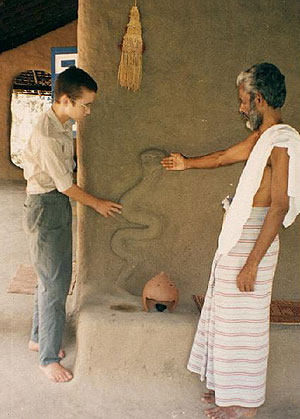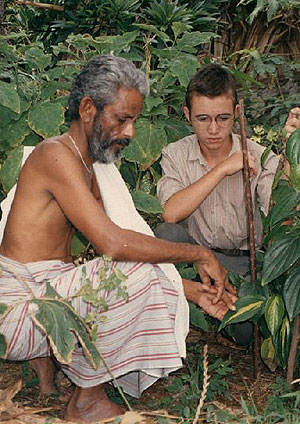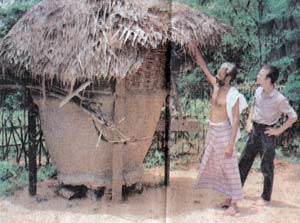|
| |||||||||

Theo’s Adventures in Alternative LankaEpisode I: Over the RainbowBy Patrick HarriganFrom The Island (Colombo) of Sunday 22nd September 1991Theo Kruszewski is just like any other contemporary American teenager. At least, in some ways he is. The fifteen-year-old high school student from Detroit, Michigan, recently became the first foreign student ever to take part in a bold experimental programme in educational research that aims to re-acquaint modern-educated youth with the visionary marvels of Lanka's ancient alternative culture. A typical American teenager from the Motor City on this first visit to Sri Lanka, Theo soon found himself revolving through the kaleidoscopic world of traditional oriental culture. Called, appropriately enough, 'Discover Lanka', the three-month summer intensive orientation programme was conducted jointly by Cultural Survival of Sri Lanka and the Kataragama Devotees Trust. Drawing upon a colourful pool of local urban and rural talent, the two organizations have teamed up with business and government to coordinate efforts to promote environmentally conscious tourism and education. Young Theo's pioneering odyssey through Sri Lanka combined fun and adventure with serious front-line research into the miraculous world of alternative Lanka that still lives on in inconspicuous ways. According to the villagers or 'little people' who preserve and transmit an astonishing diversity of archaic oral and performative traditions, a magical Kingdom of Lanka still exists that is described as being invisible or 'underground'. The next generation of scientific researchers into this mysterious twilight world — so knowledgeable sources predict — may be young pilgrim-explorers keen to rediscover the 'Lost Lemuria' and its fabulous wealth. "Sri Lanka is totally awesome once you get into it deeply," admitted Theo shortly before flying back to Detroit to rejoin anxious loved ones and to resume his normal school classes. "But who is going to believe all this?" he adds, turning his gaze upwards. "I can hardly believe it myself!" For three months the soft-spoken American youth had been exploring the nooks and crannies of island Lanka in the guise of a foreign pilgrim moving about in the company of older, more experienced pilgrims. Wearing local dress, sleeping under trees or in temples by night and never knowing for certain what to expect next, Theo learned how to see the world as others see it, often much to his own astonishment. Adjusting to conditions in Sri Lanka was not too difficult for Theo, who from age two to six had grown up in New Delhi where he and his American parents became accustomed to Indian food, customs, and ways of thought. There in India Theo's father Dr. Greg Kruszewski happened to play a minor role as a foreign journalist in the screen epic Gandhi. After returning to the States, young Theo himself, with the tutelage and encouragement of his parents, made an early career of modeling for fashion ads and appearing on television commercials aired in Europe as well as in America. With his own pocket money that he had earned for his part in a campaign of antismoking commercials for the Michigan State Department of Health, Theo chose to take a bold gamble. With the permission and blessing of his parents who are both charter members of the Cultural Survival network, he decided to go alone to far off Sri Lanka during his summer holidays to enrol as a research trainee in the Discover Lanka programme. Marvellous placeBefore he could discover Lanka, however, Theo had to do some special assignments to prepare himself for its alternative culture. On top of his normal school workload, he undertook a study of Lankan culture, religions, and related topics. To ready himself for the topsy-turvy surprises of alternative cultures, he was advised to read the classic works of Mark Twain and Lewis Carroll. "Lewis Carroll created Alice as a character and had her discover a Looking-Glass World that mirrored the so-called reality of the Victorian age", Theo observes, adding that the American storyteller Mark Twain also visited Sri Lanka and India for three months long ago in 1886. "I also found out through reading that the ancient Egyptians, Greeks, and Romans all used to say that Lanka or Taprobane was this marvelous bizarre place where everything works backwards and where the most extraordinary things are commonplace," Theo adds, displaying his erudition. "The ancients agreed that Lanka must be the Antipodes, a kind of separate underworld of its own, called the Antichthones or 'Backwards World'. What we're trying to find out is, does that world still exist here? It would be exciting to find it." Theo's first encounter with villagers and village culture in Sri Lanka took place, oddly enough, within the walled gardens of central Colombo's Taj Samudra five-star complex. There on one sheltered acre the Cultural Survival enthusiasts maintain the Samudra Cottage, a typical, Vanni homestead that doubles as an innovative research facility and education centre. That first encounter was with the renowned Vanni farmer and Sinhala folklorist Nikaveratiya Mudiyanse Tennekoon (cousin of the ex-M.P.), with whom Theo was to spend the first weeks as an apprentice researcher. Farmer Tennekoon thus recalls being introduced to young Theo. "That first day at the Samudra Cottage, I was even more happy to meet this boy than to meet an adult foreigner. I wanted to learn something from him especially his cultural pattern of life. He was my teacher." "We stayed for a few days at the cottage. I showed him how to wear the sarong. He used to sleep on the verandah," Farmer Tennekoon recalls. "Theo used to explain American culture to me, and I would tell him how these are the customs or ways to behave in this country among the village people. Otherwise, how would he appreciate our culture?" One day, Theo wanted to learn about our betel-chewing custom. I explained how we offer betel to the gods, the Buddhas, our parents, teachers and all other respectable people. And I showed him how to do it." "I showed Theo the special variety of betel leaf that we grow in the cottage garden, called Nagavalli. When Naga Rajah, the king of the Naga ('serpent') world, left that world and came to ours, he landed here on Nagadeepa (Sri Lanka) and made an offering of Nagavalli to Mother Earth. You can't buy it in the marketplace; it is only for domestic use." "He asked me what the bissa (paddy bin) was for, how to put paddy in, how to take it out. I told him how a wild fruit, the kukurumahan, is used to protect the paddy from insects. It has a very attractive smell, but once the insects touch it they know it is harmful to them". "For Wesak full moon day we went to Kataragama and spent the whole night on Ravana Galla, Ravana's Rock. There Theo could learn about Kona Dharma." "What is Kona Dharma?" Tennekoon asks. "It's what we call the nature (dharma) of a place or corner (kona). We live in the Southern Quarter, one of the four corners of the world. Farther south you find only water." KataragamaLater Theo was to return to Kataragama, only this time walking on foot from Trincomalee with other Kataragama Pada Yatra pilgrims. But even before that, the Sinhala farmer-folklorist escorted the teenage American researcher on a two-week orientation tour of the Vanni heartland. Farmer Tennekoon recalls the duo's experience of the Vanni: "First we went to Nathagame Sath Pattini temple in Kurunegala district. Nathagame is a rain catchment forest of the Kola Amunu Oya that supplied water to Panduras Nuwara, the ancient capital city of Sri Lanka from before the Anuradhapura period. There Theo could see about our ancient tank irrigation system." "We stayed as guests of the village. In no time at all, Theo became just like a village boy. It is a mountainous region. He used to go climbing the peaks with other boys of his age, even to places where I wouldn't go." "These boys, what language did they use? Theo only knows English and the village boys don't speak English. Their age is the link. They communicated with the hands and eyes. We call it 'ingiya' the wink language'." "On the third day we went to Kadawala Gedara, to its village temple and pirivena (monastic school), so that Theo could associate with the young novice Buddhist monks of his age. There he used to talk about Buddha Dhamma with the chief monk who understood some English. I also helped. We stayed there for two days". "Then we stayed for a couple of days as guests of the village of Kosdeniya at the foot of Madagama Peak where Prince Vijaya's body was cremated. One day we went to the village school where Theo spoke to students of his age and to their teachers. I think they will all remember it". "At Devagiri Raja Maha Vihara we met the chief monk and novices, spent two days, and participated in a house-opening ceremony and all night pirith chanting. Theo became friendly with all the Buddhist monks who came from different temples to the function," recalls Farmer Tennekoon. "After that we went to Munneswaram and stayed at the pirivena there. We went around and paid our respects at the temples of Gana Deviyo, Kali, Ishwara, Pattini and Lord Buddha. I explained to Theo how I had experienced for myself the terrific goddess's mysterious power called Kali Shakti". "We also went to Bihalpola Sripada Raja Maha Viharaya so Theo could meet the Buddhist monks and see the ancient temples of Bihalpola. Then we went to meet a dasa sil matha (lady hermit) where we practiced meditation with her and other meditators. Theo could understand that it was something completely different from the formalities of life in the Buddhist temples." "Finally we went to Mathawa village and stayed with a farming family. Theo got friendly with the village children. They would all go to the river to play and bathe together. We were invited here and there for meals, and were able to speak frankly with the village elders." "From moving with Theo, I could learn this," Farmer Tennekoon concludes. "If any man can respect others and their culture, he can be a member of the village. And the village won't look at him as an outsider." What did Theo learn during his first few weeks in Sri Lanka? He tells it like this: "Farmer Tennekoon and I went to all these remote villages and to ancient places like Panaduras Nuwara and Munneswaram. I found out that there is much more to village culture than I had thought." "He showed me how the land's fertility is connected to the fertility of the animals and humans who live on it and to the quality of their thoughts. I learned that the ancient kings of Lanka were like big farmers and that even the small farmers were also kings in their own way." "That was my introduction to Alternative Lanka. I found out that Lanka is this place in the human mind — like Paradise — that also exists right here on earth." Next: Theo and friends walk to Kataragama. Patrick Harrigan is acting editor of the Kataragama Research Publications Project. He also serves as research consultant to Cultural Survival of Sri Lanka. Part Two of Theo's Adventures in Alternative Lanka: Theo's Odyssey Begins | Part Three of Theo's Adventures in Alternative LankaThis article first appeared in The Sunday Island (Colombo) of 22 September 1991. Theo's summer in Sri Lanka was sponsored by the Kataragama Devotees Trust and Cultural Survival of Sri Lanka. |



